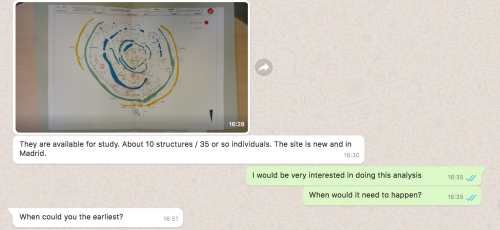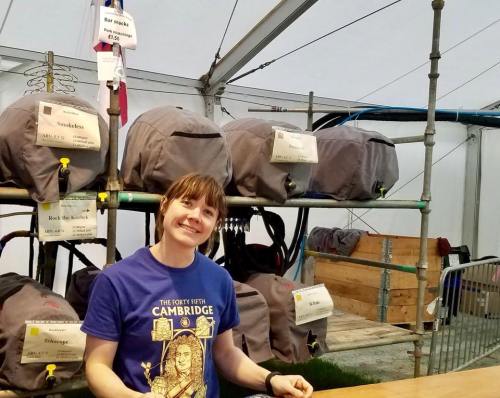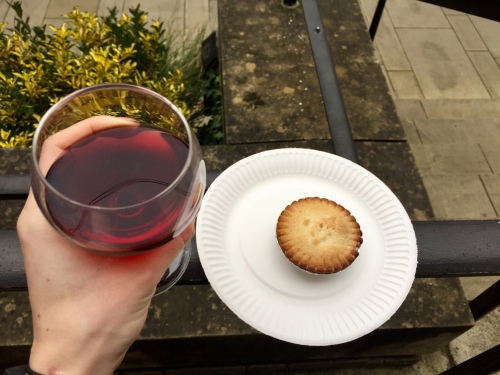2018? More like twenty-LATE-teen, at least when it came to blogging. I only published four posts this past year, in part is because I spent over three months away from Cambridge conducting bioarchaeological research. When thinking back over the preceding year I’m faced with a murky haze that likely contains equal amounts of coffee, procrastination, and time on the road.

In an attempt to figure out why I was such an abysmal updater, and to reflect on my year itself, here’s a brief description of what I got up to on a month-by-month basis below.
January
After returning from a friend’s wedding in Kenya over the holiday period, I spent two weeks in Cambridge. I had one Skype interview for a job in the US before embarking on a ten day research trip to Germany from January 14-23, where I visited my colleague Marta Díaz-Bonita Zorilla at the University of Tübingen to analyze a commingled deposit of human remains from inside an enclosure ditch at the Spanish Copper Age site of Marroquíes. I then headed to Jena by the most circuitous train route imaginable to visit my friend Elizabeth Nelson and drop off ancient DNA samples from Transylvania with collaborator Wolfgang Haak, both of whom are based at the Max Planck Institute for the Study of Human History. Betsy took me on a tour of the aDNA lab in Jena, which was one of the most memorable experiences of the winter. Later in the month I began auditing Tamsin O’Connell’s biomolecular archaeology module of the MPhil Archaeological Science Course here at the McDonald to learn more about isotopic analysis. I attended six lectures, seminars, or practicals at the tail end of the month while working on revisions to a co-authored paper that had been submitted to Antiquity in August of 2017.
February
February was largely consumed with job interviews in the United States, so I spent the end of January and the first week of February honing my job talk, including giving a practice presentation to the Bioarchaeology Reading Group on February 1. I also finished sitting in on Tamsin’s biomolecular archaeology module, attending another three lectures or seminars. On February 10 we submitted our Antiquity revisions, and I spent February 6-14 back in the US for the job interviews themselves. Likely to distract myself from the outcome of said interviews (spoiler: they went well but I did not get an offer at either institution) I posted two updates on the blog later that month, covering two of my publications that came out in MENGA: Journal of Andalusian Prehistory.
 The first was a publication of the results of my dissertation research on the site of Marroquíes, and the second was a collaboration with colleagues working on preliminary isotopic analyses of humans buried at the famous Chalcolithic site of Los Millares. Finally, on February 27 we received word that our Antiquity paper was accepted. Covering the strontium and oxygen isotopic results from Marroquíes, this represented the second major paper of my dissertation research. Given that I defended in August 2016, this gives you some idea of the inherent time lag involved in archaeological publishing…
The first was a publication of the results of my dissertation research on the site of Marroquíes, and the second was a collaboration with colleagues working on preliminary isotopic analyses of humans buried at the famous Chalcolithic site of Los Millares. Finally, on February 27 we received word that our Antiquity paper was accepted. Covering the strontium and oxygen isotopic results from Marroquíes, this represented the second major paper of my dissertation research. Given that I defended in August 2016, this gives you some idea of the inherent time lag involved in archaeological publishing…
March
I kicked off the month by giving a talk in the Biological Anthropology PhD Professional Development Series titled “Effective Conference Presentations and Networking” on March 6th. I spent from the 12-15 visiting Copenhagen, in an attempt to take advantage of being so close to Europe, and drank all of the beer that To Øl and Mikkeller had to offer. Upon my return I staffed a table at the University of Cambridge Science Festival, working with my friend and colleague Laerke Recht to teach young children about osteology using an activity that I developed and Laerke illustrated titled “Game of Bones“. I also spent a significant amount of time this month assembling a manuscript to submit to the Journal of Anthropological Archaeology, spending hours R-wrangling in order to make beautifully colored figures:
 and dealing with constructive criticism from collaborators, while sending multiple paper drafts back and forth.
and dealing with constructive criticism from collaborators, while sending multiple paper drafts back and forth.
April
The beginning of April was devoted to conference preparations and related travel, as I was giving both a poster and a podium presentation at the annual Society for American Archaeology conference. I spent April 11-15 at the SAA meetings in Washington DC, and five days later submitted the paper on the results of dietary isotopic analysis (C, N) to JAA. At the end of the month an idea for a new paper started to percolate, this one on publishing decisions in archaeology, and so I outlined my ideas for research questions and organized meetings with potential collaborators. I also began modifying a manuscript that has been in the works since I finished my dissertation, a piece on developing dental methods for evaluating prehistoric commingled assemblages. Sadly I am only now getting back into it, but I have (perhaps grandiose) hopes of submitting it in the next two months.
 May
May
May was a month of receiving requests for reviews and preparing for summer fieldwork. I was asked to review a book for American Antiquity on May 11, and sent in reviews to Open Archaeology on the 14th, and the Archaeological Review of Cambridge on the 16th. I already felt fairly overwhelmed by the prospect of preparing for a long stint of fieldwork in Transylvania when, on May 23, my collaborator Pedro Díaz-del-Río sent me an invitation on WhatsApp that I could not turn down.

I suddenly found myself preparing for not one, not two, but three months of bioarchaeological data collection, and mapping out the logistics of travel, housing, and storing all of my belongings in the office (so as to avoid paying summer rent for no reason) took several weeks. I spent the last few days of the month attending a (mandatory, because of British risk assessment policies) First Aid course at St John Ambulance. Perhaps the most important achievement unlocked in May, however, was that it was my first time volunteering at the Cambridge Beer Festival, which was one of the high points of my year.

June
One June 5 I left for two months in Romania. The MARBAL team spent the first four weeks excavating at the site of Ramet-Gugului, working with three undergraduate students from Hamilton College. Our students posted on travelling to Romania, and food in the field, while the the project was featured on the Hamilton College Blog. In late June our colleagues and friends Liviu and Raluca took us on a fantastic field trip to the site of Ampoița, and my father came out to visit to help out with the end of the season (including backfill day), an experience documented in his engaging blog post “Archaeology 101“. Field days were long, and evenings were spent cooking, preparing for the next day in the field, working with Colin Quinn to send out invitations to participants for an SAA 2019 session we are organizing, and reading the edited volume I was reviewing, a Sisyphean task that unexpectedly took me all summer.
July
July was devoted to bioarchaeological data collection, with three and a half weeks spent conducting analyses of over 17 individuals from eight Bronze Age sites, and selecting around 60 human and faunal samples for isotopic analysis back in Cambridge. On July 11 I received reviews for our JAA article, and on July 15 I submitted an article review to Advances in Archaeological Practice; when not hunched over trays of fragmentary bones and teeth, my limited downtime was spent reviewing or revising papers. We also had a bat decide to roost in our apartment bathroom the night of July 26, during our last few days of data collection. Not a lot of sleep in July, as I recall.
August
The team left Alba Iulia and headed for Cluj on July 28, then made our way to Budapest via shuttle on July 29. We had two days in Budapest, and then I attempted to return to Cambridge via RyanAir on July 31. One cancelled flight later, I made it back to town on August 01. After four days furiously reorganizing my belongings and soaking in the long summer days I was bound for my next port-of-call: the Consejo Superior de Investigaciones Científicas in Simancas in Madrid, where I would spend the next four weeks in a museum basement analyzing human remains from a Copper Age enclosure site that had just been excavated. There were 50 deposits of human remains, rather than 35, so this was another month of very limited sleep. In what little spare time I had I worked on the proofs for the JAA paper, and attempted to assemble my two podium presentations for the European Association of Archaeologists meetings that would be held in Barcelona in September.

September
I arrived in the beautiful metropolis of Barcelona in early September to spend several days exploring…the confines of my hotel room. I simply had not had enough down-time to prepare two solo podium presentations while collecting data in August, which meant for some fast-paced powerpoint slide construction. Despite my sleep-deprived state, both went swimmingly. My first was “Embodied Inequality: Bioarchaeological Approaches to Inequality in Copper Age Iberia,” presented in a festschrift session for Antonio Gilman organized by Katina Lillios and Pedro Díaz-del-Río. The session was wonderful, and despite it being an all-day session the material was compelling enough to keep me seated for all of the papers.

The second, “Pattern, Process, and Processing: Post-Mortem Interactions with the Dead in Late Prehistoric Europe,” was part of a session organized by Lizzie Craig-Atkins and my friend Alexandra Ion, titled “Manipulated Bodies: Case Studies of Post-Mortem Interactions with Human Remains.” Though mercifully shorter than the Gilman session, it was also full of compelling case studies.
Because two conference presentations in three days was not enough, while at the EAAs I also submitted the proposal for our SAA symposium “Living and Dying in Mountain and Highland Landscapes,” which was recently accepted and will take place at the meetings in Albuquerque this year. Upon returning to Cambridge and moving all of my belongings from my office into my new flat I fell into a deep sleep for several days, rousing only to submit my long-fermenting book review to American Antiquity on September 14. At the end of the month, I also left town for long enough to visit Lyme Regis, a seaside town on the Jurassic Coast well worth a trip both for its ammonite hunting opportunities, and its site as the longstanding habitat of novelist John Fowles.

October
After reviving from the world’s longest stint of summer data collection, I spent much of October learning how to prepare collagen samples for carbon and nitrogen isotopic analysis, tutored by the inimitable Emma Lightfoot. The most important step is not to in any way absorb or ingest hydrochloric acid; thus far I have done quite well. I also submitted a second round review for Advances in Archaeological Practice, volunteered at a McDonald Institute Prehistory Day on October 20, and gave a talk for the Biological Anthropology PhD Professionalization series titled “Introduction to the US Academic Job Market” with visiting scholar (and fellow Michigan grad) Zachary Cofran.

November
In November I submitted two grant applications (one internal, one external), was elected* Postdoc Visibility Representative by the Postdoc Committee at the McDonald, took a weekend trip to visit York, and submitted a survey I’m circulating on publishing decisions in archaeology to the Ethics Committee, got it approved, and had it live for three weeks. On November 18 I took a day trip with other members of the isotope lab to the Anglo-Saxon village at West Stowe, and on the 24th Chris Knüsel visited for a Taphonomy Workshop, co-organized with John Robb and hosted by the Bioarchaeology Reading Group. I also volunteered at the Cambridge Winter Beer Festival, which was just as fun as the summer beer festival, though slightly smaller-scale. Over the course of the rest of the month I finished getting my second batch of isotope samples into the -20 freezer in advance of upcoming travel.
*I.e. had other postdocs tell me it was mandatory
December
I spent December weighing my second batch of isotope samples and outlining writing projects for the new year, prepping my third batch of isotope samples, and reviewing a paper for JAS: Reports. I had family visiting early in the month for a trip to Scotland, and by the time I got back the holiday season had started in earnest, with mince pies and mulled wine in the McDonald lobby, the annual GPR Christmas party (this year, 80s themed), and the Churchill College Christmas Dinner. The holidays themselves were spent in Cambridge and Coventry, taking lots of long cycle rides and drinking lots of beer.
From the October to December period, I also applied for 10 tenure-track jobs, finished processing two batches (74 samples) of prehistoric human or faunal bone collagen for C and N, knit three hats, and pr’ed my deadlift. In hindsight, it appears 2018 was a relatively busy year, and I have done my best to spend time accruing data that I can turn into publications over the next two to three years. I have plenty of resolutions for the New Year, and I’m hoping to get back on track with blog posts and post at least two times per month. Wish me luck!










Fantastic post, 2018 sounds like a very productive year for research, data collection and analysis, not to mention professionally. Loved reading your father’s post as well, made me chuckle a few times!
LikeLike
Thank you so much for your website! It saved (practically) my entire class during our skeletal biology class. We worked off of Tim White’s book (We’re at a UC that I’ll leave undisclosed), and somehow your guides were key to making us pros during the exams.
LikeLike
Sami! This comment made my morning. Wonderful to hear, and I hope you all passed. Let me know if there’s an anatomical region you’d like me to create a guide for, as I’m trying to motivate myself to get back into blogging.
LikeLike